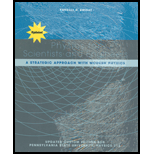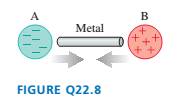
PHYS 212 FOR SCI+ENG W/MAST PHYS >ICP<
1st Edition
ISBN: 9781323834831
Author: Knight
Publisher: PEARSON C
expand_more
expand_more
format_list_bulleted
Concept explainers
Textbook Question
Chapter 22, Problem 8CQ
The two oppositely charged metal spheres in FIGURE Q22.8 have
equal quantities of charge. They are brought into contact with a
neutral metal rod. What is the final charge state of each sphere
and of the rod? Use both charge diagrams and words to explain.

Expert Solution & Answer
Want to see the full answer?
Check out a sample textbook solution
Students have asked these similar questions
No chatgpt pls will upvote
No chatgpt pls will upvote
l
Chapter 22 Solutions
PHYS 212 FOR SCI+ENG W/MAST PHYS >ICP<
Ch. 22 - l. Can an insulator be charged? If so, how would...Ch. 22 - Can a conductor be charged? If so, how would you...Ch. 22 - Four lightweight balls A, B, C, and D are...Ch. 22 - Charged plastic and glass rods hang by threads. a....Ch. 22 - A lightweight metal ball hangs by a thread. When a...Ch. 22 - Prob. 6CQCh. 22 - Prob. 7CQCh. 22 - The two oppositely charged metal spheres in FIGURE...Ch. 22 - Metal sphere A in FIGURE Q22.9 has 4 units of...Ch. 22 - Prob. 10CQ
Ch. 22 - Prob. 11CQCh. 22 - Prob. 12CQCh. 22 - Reproduce FIGURE Q22.13 on your paper. Then draw a...Ch. 22 - Prob. 14CQCh. 22 - The electric force on a charged particle in an...Ch. 22 - A glass rod is charged to +8.0 nC by rubbing. a....Ch. 22 - Prob. 2EAPCh. 22 - 3. A plastic rod that has been charged to —15 nC...Ch. 22 - A glass rod that has been charged to + 12 nC...Ch. 22 - Prob. 5EAPCh. 22 - Prob. 6EAPCh. 22 - Prob. 7EAPCh. 22 - A linear accelerator uses alternating electric...Ch. 22 - Prob. 9EAPCh. 22 - Two neutral metal spheres on wood stands are...Ch. 22 - Prob. 11EAPCh. 22 - You have two neutral metal spheres on wood stands....Ch. 22 -
13. Two 1.0 kg masses are 1.0 m apart (center...Ch. 22 - Two small plastic spheres each have a mass of 2.0...Ch. 22 - Prob. 15EAPCh. 22 - Two protons are 2.0 fm apart. What is the...Ch. 22 - What is the net electric force on charge A in...Ch. 22 - What is the net electric force on charge B in...Ch. 22 - What is the force F on the 1.0 nC charge in FIGURE...Ch. 22 - What is the force on the 1.0nC charge in figure...Ch. 22 - Object A, which has been charged to +4.0 nC, is at...Ch. 22 - A small plastic bead has been charged to —15 nC....Ch. 22 - A 2.0 g plastic bead charged to —4.0 nC and a 4.0...Ch. 22 - Two positive point charges q and 4q are at x = O...Ch. 22 - A massless spring is attached to a support at one...Ch. 22 - What are the strength and direction of the...Ch. 22 - The electric field at a point in space is E =...Ch. 22 - Prob. 28EAPCh. 22 - What magnitude charge creates a 1.0 N/C electric...Ch. 22 - Prob. 30EAPCh. 22 - Prob. 31EAPCh. 22 - A + 12 nC charge is located at the origin. a. What...Ch. 22 - A —12 nC charge is located at (x, y) = (1.0 cm, 0...Ch. 22 - A 0.10 g honeybee acquires a charge of +23 pC...Ch. 22 - Prob. 35EAPCh. 22 - 36. Two 1.0 g spheres are charged equally and...Ch. 22 - 37. The nucleus of a 125Xe atom (an isotope of...Ch. 22 - Prob. 38EAPCh. 22 - Prob. 39EAPCh. 22 - Objects A and B are both positively charged. Both...Ch. 22 - What is the force F on the —10 nC charge in FIGURE...Ch. 22 - What is the force F on the —10nC charge in FIGURE...Ch. 22 - 43. What is the force on the 5.0 nC charge in...Ch. 22 - Prob. 44EAPCh. 22 - What is the force F on the 1.0 nC charge at the...Ch. 22 - What is the force F on the 1.0 nC charge at the...Ch. 22 - Prob. 47EAPCh. 22 - The net force on the 1.0 nC charge in FIGURE...Ch. 22 - Prob. 49EAPCh. 22 - A positive point charge Q is located at x=a and a...Ch. 22 - Prob. 51EAPCh. 22 - FIGURE P22.52 shows three charges and the net...Ch. 22 - Prob. 53EAPCh. 22 - Prob. 54EAPCh. 22 - You have two small, 2.0 g balls that have been...Ch. 22 - A 2.0 g metal cube and a 4.0 g metal cube are 6.0...Ch. 22 - Prob. 57EAPCh. 22 - Prob. 58EAPCh. 22 - Prob. 59EAPCh. 22 - Prob. 60EAPCh. 22 - Prob. 61EAPCh. 22 - Two 5.0 g point charges on 1.0-m-long threads...Ch. 22 - Prob. 63EAPCh. 22 - Prob. 64EAPCh. 22 - 65. A 10.0 nC charge is located at position (1.0...Ch. 22 - Prob. 66EAPCh. 22 - An electric field E = 100,000i N/C causes the 5.0...Ch. 22 - An electric field E = 200,000i N/C causes the...Ch. 22 - Prob. 69EAPCh. 22 - In Problems 69 through 72 you are given the...Ch. 22 - Prob. 71EAPCh. 22 - Prob. 72EAPCh. 22 - Prob. 73EAPCh. 22 - Three 3.0 g balls are tied to 80-cm-long threads...Ch. 22 - 75. IN ne identical small spheres shown in FIGURE...Ch. 22 - 76. The force on the -1.0 nC charge is as shown in...Ch. 22 - 77. In Section 22.3 we claimed that a charged...
Knowledge Booster
Learn more about
Need a deep-dive on the concept behind this application? Look no further. Learn more about this topic, physics and related others by exploring similar questions and additional content below.Similar questions
- Which of the following best describes how to calculate the average acceleration of any object? Average acceleration is always halfway between the initial acceleration of an object and its final acceleration. Average acceleration is always equal to the change in velocity of an object divided by the time interval. Average acceleration is always equal to the displacement of an object divided by the time interval. Average acceleration is always equal to the change in speed of an object divided by the time interval.arrow_forwardThe figure shows the velocity versus time graph for a car driving on a straight road. Which of the following best describes the acceleration of the car? v (m/s) t(s) The acceleration of the car is negative and decreasing. The acceleration of the car is constant. The acceleration of the car is positive and increasing. The acceleration of the car is positive and decreasing. The acceleration of the car is negative and increasing.arrow_forwardWhich figure could represent the velocity versus time graph of a motorcycle whose speed is increasing? v (m/s) v (m/s) t(s) t(s)arrow_forward
- Unlike speed, velocity is a the statement? Poisition. Direction. Vector. Scalar. quantity. Which one of the following completesarrow_forwardNo chatgpt pls will upvote Already got wrong chatgpt answerarrow_forward3.63 • Leaping the River II. A physics professor did daredevil stunts in his spare time. His last stunt was an attempt to jump across a river on a motorcycle (Fig. P3.63). The takeoff ramp was inclined at 53.0°, the river was 40.0 m wide, and the far bank was 15.0 m lower than the top of the ramp. The river itself was 100 m below the ramp. Ignore air resistance. (a) What should his speed have been at the top of the ramp to have just made it to the edge of the far bank? (b) If his speed was only half the value found in part (a), where did he land? Figure P3.63 53.0° 100 m 40.0 m→ 15.0 marrow_forward
- Please solve and answer the question correctly please. Thank you!!arrow_forwardYou throw a small rock straight up from the edge of a highway bridge that crosses a river. The rock passes you on its way down, 5.00 s after it was thrown. What is the speed of the rock just before it reaches the water 25.0 m below the point where the rock left your hand? Ignore air resistance.arrow_forwardHelp me make a visualize experimental setup using a word document. For the theory below.arrow_forward
arrow_back_ios
SEE MORE QUESTIONS
arrow_forward_ios
Recommended textbooks for you
 Physics for Scientists and Engineers: Foundations...PhysicsISBN:9781133939146Author:Katz, Debora M.Publisher:Cengage Learning
Physics for Scientists and Engineers: Foundations...PhysicsISBN:9781133939146Author:Katz, Debora M.Publisher:Cengage Learning College PhysicsPhysicsISBN:9781938168000Author:Paul Peter Urone, Roger HinrichsPublisher:OpenStax College
College PhysicsPhysicsISBN:9781938168000Author:Paul Peter Urone, Roger HinrichsPublisher:OpenStax College Physics for Scientists and Engineers with Modern ...PhysicsISBN:9781337553292Author:Raymond A. Serway, John W. JewettPublisher:Cengage Learning
Physics for Scientists and Engineers with Modern ...PhysicsISBN:9781337553292Author:Raymond A. Serway, John W. JewettPublisher:Cengage Learning Principles of Physics: A Calculus-Based TextPhysicsISBN:9781133104261Author:Raymond A. Serway, John W. JewettPublisher:Cengage Learning
Principles of Physics: A Calculus-Based TextPhysicsISBN:9781133104261Author:Raymond A. Serway, John W. JewettPublisher:Cengage Learning Physics for Scientists and Engineers, Technology ...PhysicsISBN:9781305116399Author:Raymond A. Serway, John W. JewettPublisher:Cengage Learning
Physics for Scientists and Engineers, Technology ...PhysicsISBN:9781305116399Author:Raymond A. Serway, John W. JewettPublisher:Cengage Learning College PhysicsPhysicsISBN:9781305952300Author:Raymond A. Serway, Chris VuillePublisher:Cengage Learning
College PhysicsPhysicsISBN:9781305952300Author:Raymond A. Serway, Chris VuillePublisher:Cengage Learning

Physics for Scientists and Engineers: Foundations...
Physics
ISBN:9781133939146
Author:Katz, Debora M.
Publisher:Cengage Learning

College Physics
Physics
ISBN:9781938168000
Author:Paul Peter Urone, Roger Hinrichs
Publisher:OpenStax College

Physics for Scientists and Engineers with Modern ...
Physics
ISBN:9781337553292
Author:Raymond A. Serway, John W. Jewett
Publisher:Cengage Learning

Principles of Physics: A Calculus-Based Text
Physics
ISBN:9781133104261
Author:Raymond A. Serway, John W. Jewett
Publisher:Cengage Learning

Physics for Scientists and Engineers, Technology ...
Physics
ISBN:9781305116399
Author:Raymond A. Serway, John W. Jewett
Publisher:Cengage Learning

College Physics
Physics
ISBN:9781305952300
Author:Raymond A. Serway, Chris Vuille
Publisher:Cengage Learning
Electric Fields: Crash Course Physics #26; Author: CrashCourse;https://www.youtube.com/watch?v=mdulzEfQXDE;License: Standard YouTube License, CC-BY